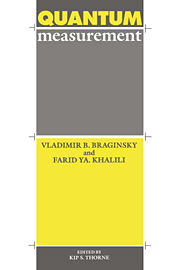Book contents
- Frontmatter
- Contents
- Dedication
- Editor's Foreword
- Notation
- Chapter I Historical introduction: photons and measurements using photons
- Chapter II The main principles of quantum mechanics
- Chapter III Indirect measurements
- Chapter IV Quantum nondemolition measurements
- Chapter V Linear measurements
- Chapter VI Continuous linear measurements
- Chapter VII Nonlinear systems for continuous measurements
- Chapter VIII Detection of classical forces
- Chapter IX Energetic quantum limitations
- Chapter X Devices for measuring small mechanical displacements
- Chapter XI Quantum nondemolition measurements of a resonator's energy
- Chapter XII Nonclassical states of electromagnetic waves as tools for quantum measurements
- Conclusion
- References
- Subject Index
Chapter I - Historical introduction: photons and measurements using photons
Published online by Cambridge University Press: 15 December 2009
- Frontmatter
- Contents
- Dedication
- Editor's Foreword
- Notation
- Chapter I Historical introduction: photons and measurements using photons
- Chapter II The main principles of quantum mechanics
- Chapter III Indirect measurements
- Chapter IV Quantum nondemolition measurements
- Chapter V Linear measurements
- Chapter VI Continuous linear measurements
- Chapter VII Nonlinear systems for continuous measurements
- Chapter VIII Detection of classical forces
- Chapter IX Energetic quantum limitations
- Chapter X Devices for measuring small mechanical displacements
- Chapter XI Quantum nondemolition measurements of a resonator's energy
- Chapter XII Nonclassical states of electromagnetic waves as tools for quantum measurements
- Conclusion
- References
- Subject Index
Summary
In the standard, textbook treatment of quantum mechanics, the contact with experiment is described in terms of probabilities for obtaining this, that, or another result, when identical experiments are performed on a huge number (ensemble) of identical objects. Such an ensemble description was adequate during the first half century of quantum theory, because the technology of that era was incapable of making a measurement without destroying or severely changing the measured object (photon, atom, …). In recent years, however, advances in technology and technique have made possible repetitive quantum measurements on a single quantum object, with each measurement influencing the object only minimally. Such measurements cannot be analyzed using solely the ensemble theory. Additional theoretical concepts are needed. The purpose of this book is to describe the methods and theory of such measurements (as well as the more elementary theory of ensembles of measurements).
This book is written for two types of readers: those who have had only a little previous contact with quantum mechanics, and those who have had much.
Readers of the first type are presumed to understand atomic physics at a qualitative level. The unstarred sections of this book offer such readers an overview of the present state-of-the-art of quantum measurements on single objects and prospects for the future, as well as an elementary overview of the theory of such measurements.
- Type
- Chapter
- Information
- Quantum Measurement , pp. 1 - 16Publisher: Cambridge University PressPrint publication year: 1992
- 1
- Cited by

